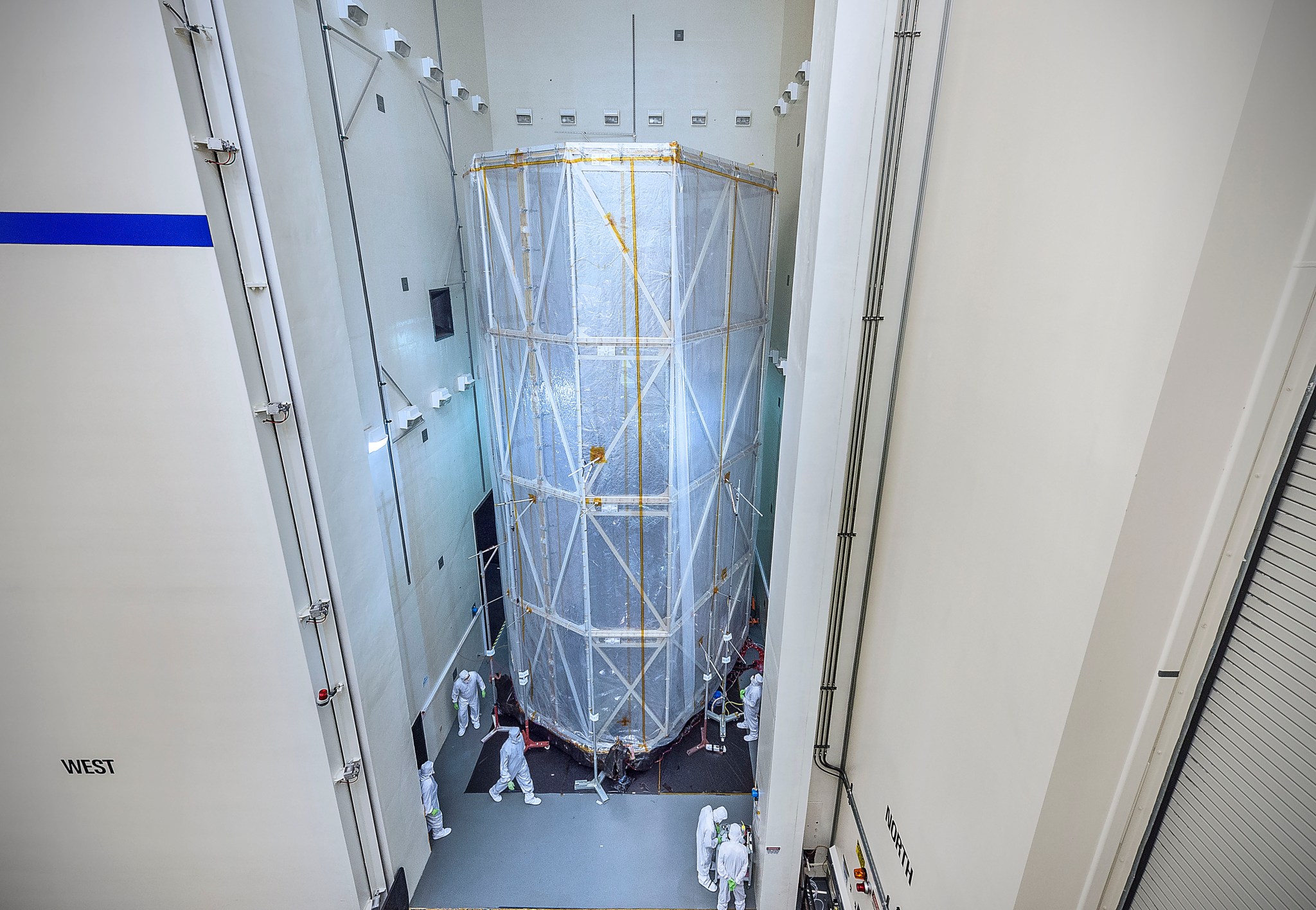The spacecraft element of NASA’s James Webb Space Telescope recently completed its first two major launch environmental tests at Northrop Grumman Aerospace Systems in Redondo Beach, California, and will soon undergo further tests to ensure it will handle the rigors of launch and the harsh environment of space.
The spacecraft element’s first test simulated the mechanical shock caused by the separation of the spacecraft’s payload adapter after launch. The second test subjected the spacecraft to the extreme sound and resultant vibration of the launch environment. These shock separation and acoustics tests are routine for all spacecraft.
Detailed inspections of the hardware after the acoustic test showed that fastening hardware that hold the sunshield membrane covers in place had come loose.
“NASA is reviewing options for repair and the next steps in spacecraft element launch environment testing,” said Greg Robinson, Webb’s program director. “The team is reviewing the test data and hardware configuration and is actively working towards corrective action in the near future. We expect to get back to the environmental test flow shortly and continue to move safely and methodically toward mission success.”
Discoveries like this one are not uncommon in the development of a complex and unique spacecraft. “This is an example of why space systems are thoroughly and rigorously tested on the ground to uncover imperfections and fix them prior to launch,” said Robinson.
Webb’s spacecraft element is the observatory’s combined sunshield and spacecraft bus. The spacecraft element and Webb’s combined optical element and science instruments, called its science payload, will form the complete observatory. The two halves currently reside at Northrop Grumman, NASA’s observatory contractor.
The shock of payload separation
When Webb is launched into space, it must be folded like origami to fit inside its Ariane 5 rocket’s payload fairing, which is about 15.1 feet (4.6 meters) wide. The fairing, also called the rocket’s nose cone, protects Webb from the forces and heat of the atmosphere as the rocket accelerates into space.
Inside the fairing, the payload adapter physically attaches Webb to the top of the Ariane 5. The adapter has two halves — one that is permanently attached to Webb and the other that is attached to the second stage of the rocket. When the rocket reaches a specific altitude in Earth’s upper atmosphere, the payload fairing is jettisoned and falls back to Earth. Following this, the first stage of the Ariane 5 expends its fuel and also is jettisoned.
After the second stage of the rocket gives Webb a final nudge to send it on its way to its orbit at the second Sun-Earth Lagrange point (L2), the two halves of the payload adapter separate, releasing Webb from the rocket. The release sends a mechanical shock — a series of high-frequency vibrations — through the observatory.
“Mechanical shock is a quick jolt to the system, a lot like when you shut your car door and the car shudders a little,” explained Keith Parrish, the Observatory Manager for Webb at NASA’s Goddard Space Flight Center in Greenbelt, Maryland. The electronics in Webb are designed to withstand this shock just as a laptop is designed to withstand the bangs and drops of everyday life.
To simulate this separation on Earth, engineers at Northrop Grumman first suspended the spacecraft element in the air with the payload adapter attached to it. They then remotely released the bottom half of the payload adapter, which is the half that will be attached to the rocket during launch. The bottom half fell approximately 8 inches (about 20 centimeters) onto a padded catch area on the floor of the cleanroom where the test was being performed.
The engineers monitored the forces caused by the release to ensure they were within expected values, and high-speed video cameras recorded the separation to make sure it was smooth. During the actual flight and separation, 12 springs will gently push Webb away from the Ariane 5.
The sound and vibration of launch
After completing shock testing, engineers enveloped the spacecraft in a plastic tent and moved it into Northrop Grumman’s Large Acoustic Test Facility. The tent protected the spacecraft from contamination during the move and during the acoustic test.
During the test, engineers subjected the spacecraft element to sound frequencies ranging from 25 Hertz to 2,500 Hertz, which is what Webb will experience during launch. These frequencies range from low bass (similar to that of a kick drum) to low treble (about the same level as the E7 key on a piano). It was also tested at loudness levels up to 142.5 decibels, about 3 decibels higher than what is expected during launch. Webb’s science payload went through a similar acoustic test at NASA’s Goddard Space Flight Center in Greenbelt, Maryland, in 2017.
Engineers mounted several microphones inside and outside the tent to monitor the acoustic environment during testing. They also mounted about 500 accelerometers around the spacecraft element to monitor the vibrational responses it experienced. An accelerometer measures the forces or stress the hardware is experiencing during the test.
After this first series of tests, Webb’s spacecraft element will undergo vibration testing to ensure it will survive the intense shake of launch.
***
NASA’s James Webb Space Telescope will be the world’s next great space science observatory. Webb will solve mysteries of our solar system, look beyond to distant worlds around other stars, and probe the mysterious structures and origins of our universe and our place in it. Webb is an international project led by NASA with its partners, the ESA (European Space Agency) and the Canadian Space Agency.
Part of the ESA’s contribution is the Ariane 5 launch vehicle, which is operated by Arianespace. Arianespace subcontractor RUAG Space provided the rocket’s payload adapter.
For more information about Webb, visit: www.nasa.gov/webb
By Eric Villard
NASA’s Goddard Space Flight Center, Greenbelt, Md.



























